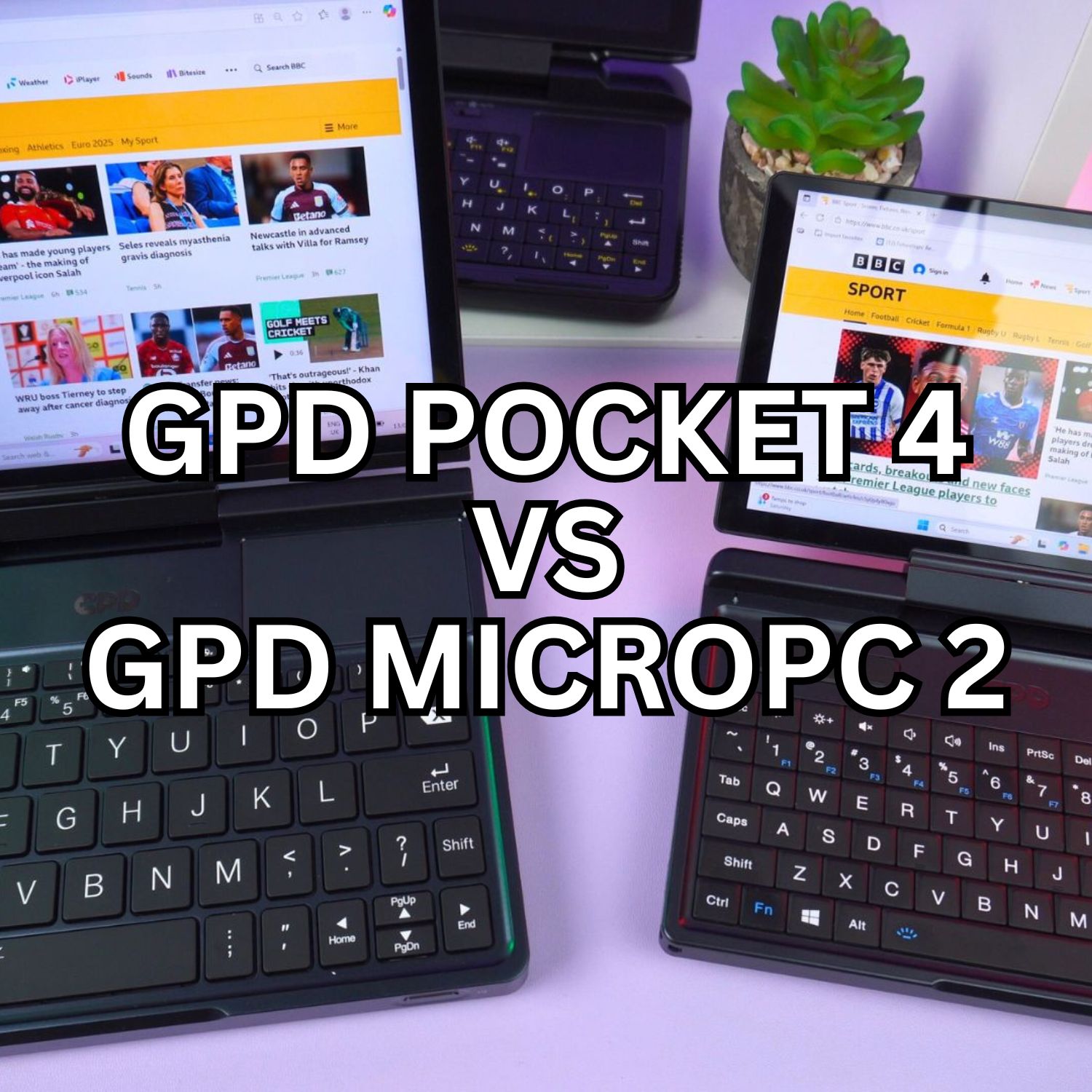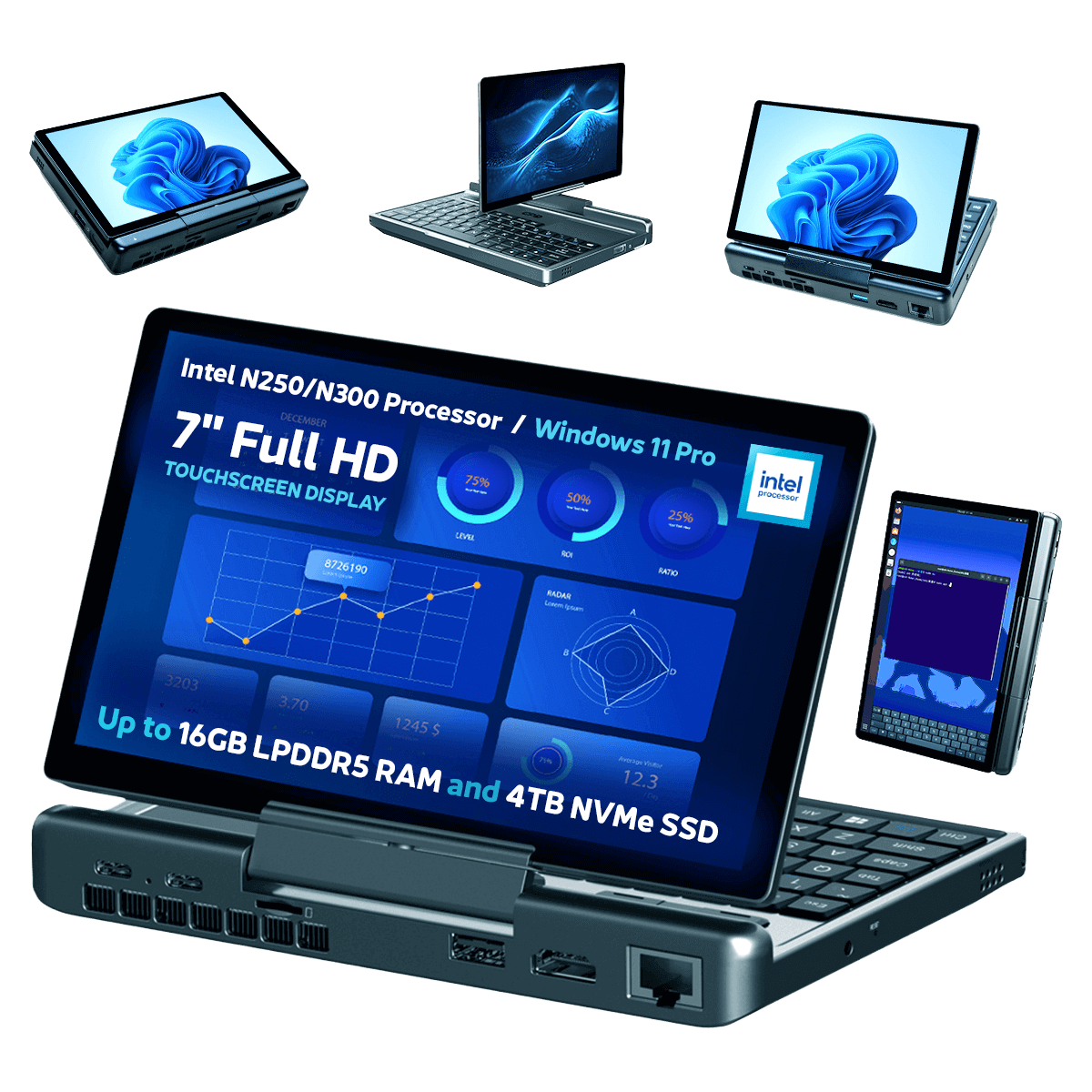
GPD MicroPC 2 frente a GPD Pocket 4: el dilema del profesional
In the thriving UMPC market, GPD presents professionals with a fascinating choice between two exceptional 2-in-1 convertible devices: the GPD MicroPC 2 and the GPD Pocket 4. Both offer the versatility of transforming from a GPD mini laptop to a tablet, but they are born from entirely different design philosophies and cater to different performance needs and budgets. This makes the decision more nuanced than ever.
Nuestro análisis detallado de la GPD MicroPC 2 vs GPD Pocket 4 está aquí para diseccionar estas diferencias y ayudarle a encontrar su herramienta profesional perfecta.
Filosofía en forma: Utilitarismo vs. Ejecutivo
The core identity of each device is evident in its construction. The GPD MicroPC 2 is built for resilience, with a high-impact ABS synthetic resin chassis designed to endure the challenges of on-site work. The GPD Pocket 4, conversely, is milled from premium CNC aluminum, presenting a sleek, polished aesthetic fit for an executive suite.

Aunque ambos comparten una innovadora bisagra de 180 grados para la funcionalidad de tableta, sus formas físicas cuentan una historia de sus entornos previstos. Ambos son portátiles compactos diseñados con maestría, pero la elección empieza por dar prioridad a la utilidad robusta o a un acabado de primera calidad.

Miniportátil GPD Pocket 4
Un espectro de potencia y precio
The starting price of each device, $570.95 for the GPD MicroPC 2 and $865.95 for the GPD Pocket 4, is the clearest indicator of the wide performance spectrum they cover.
- El eficiente caballo de batalla (MicroPC 2): Con CPU de la serie N de Intel(N250/N300), este dispositivo está optimizado para ofrecer eficiencia y fiabilidad en diagnósticos, tareas administrativas y productividad diaria.
- El ejecutivo de alto rendimiento (Pocket 4 Base): Con su procesador AMD Ryzen 7 8840U (8 Cores/16 Threads), entra en el reino de los portátiles de gama alta para empresas, manejando fácilmente la multitarea intensiva y el trabajo creativo.
- El centro neurálgico de vanguardia (Pocket 4 Top-Tier): La CPU opcional AMD Ryzen AI 9 HX 370 (12 núcleos/24 hilos) con su NPU de última generación está dirigida a desarrolladores y pioneros de la IA que necesitan potencia de sobremesa en movimiento.

Interacción e inmersión
When it comes to user interaction, the GPD Pocket 4 boasts a world-class display. Its 8.8-inch LTPS touchscreen is larger, sharper at a 2560×1600 resolution, and incredibly fluid with a 144Hz refresh rate. In contrast, the GPD MicroPC 2 7-inch LTPS 1080p 60Hz screen is highly practical and capable, but the Pocket 4’s panel is simply on another level.

Ambos dispositivos comparten un teclado retroiluminado con un diseño de entrada similar, tres botones de ratón y un touchpad, pero el mayor tamaño del Pocket 4 ofrece una experiencia de escritura más cómoda, lo que lo convierte en uno de los mejores portátiles para estudiantes que escriben redacciones con frecuencia.

Conexiones: Integradas o a medida
The central question in the GPD MicroPC 2 vs GPD Pocket 4 debate is their approach to connectivity. The GPD MicroPC 2 champions “built-in readiness.” It has a comprehensive suite of integrated ports, including a 2.5Gbps Ethernet port, ensuring you are always prepared for any standard connection scenario out of the box.

The GPD Pocket 4 champions “bespoke flexibility.” It has a powerful set of fixed ports, including a high-speed USB4 port that supports eGPU connectivity for graphics-intensive tasks. Its unique advantage is the modular port system, allowing users to swap in specialized tools like a 4G LTE module, RS-232 module or a KVM module, tailoring the device for a specific mission.

Especificaciones técnicas de GPD MicroPC 2 frente a GPD Pocket 4
| GPD POCKET 4 | GPD MICROPC 2 | |
|---|---|---|
| PANTALLA | 8.8″, 144Hz, 2560 × 1600, 10-Point Multi-Touch | 7″ LTPS 1080P 1920×1080, 60Hz, 16:9, 314 PPI, 500 nits |
| CPU | AMD Ryzen 7 8840U 8 núcleos / 16 hilos, 5,1 Ghz, 28W AMD Ryzen AI 9 HX 370, 12 núcleos / 24 hilos, 5,1Ghz, 25W | Procesador Intel N250, 4 núcleos / 4 hilos, 3,8 GHz, 6 W – 15 W Procesador Intel N300 8 núcleos / 8 hilos, 3,8 GHz, 7 W |
| GPU | AMD Radeon 780M AMD Radeon 890M | Gráficos Intel UHD integrados, 1,25 GHz, 32 unidades de ejecución |
| RAM | 32 GB o 64 GB LPDDR5x en función de la configuración de la CPU | 16 GB LPDDR5 |
| ALMACENAMIENTO | SSD NVMe PCI-E Gen 4.0 de 1 TB, 2 TB y 4 TB en función de la configuración de la CPU | 512GB/1TB/2TB/4TB M.2 2280 SSD |
| COMUNICACIONES | 1 puerto Ethernet RJ45 (2,5 Gbps) Wi-Fi 6E Bluetooth 5.3 | 1 puerto Ethernet RJ45 (2,5 Gbps) Wi-Fi 6 (hasta 2402 Mbps) Bluetooth 5.2 (admite hasta 7 dispositivos activos) |
| E/S | 1x USB4 1x USB-C 2x USB A (2.0 y 3.2 Gen 2) 1x HDMI 2.1 1x RJ45 2.5Gbps 1x conector de audio de 3,5 mm 1x puerto modular (con módulo lector de tarjetas microSD) | 2x USB Type-C 3.2 Gen2 (función completa) 2x USB-A 3.2 Gen2 1x HDMI 2.1 (protocolo TMDS, admite 4K@60Hz) 2x DisplayPort 1.4 (a través de USB-C, admite 4K@60Hz) |
| BATERÍA | Batería recargable de 45 Wh | 27,5Wh Soporta Bypass de Batería |
| DIMENSIONES | 8,14 x 5,6 x 0,87 pulgadas (20,68 × 14,45 × 2,22 cm) | 6,73 x 4,33 x 0,91 pulgadas (17,1 x 11,0 x 2,3 cm) |
| PESO | 785 g (1,7 libras) | 500 gramos (1,10 libras) |
Identificar a su pareja ideal
Su profesión probablemente guiará su elección entre estos dos excelentes 2 en 1.
- El GPD MicroPC 2 es su compañero ideal si: Es un técnico práctico, un profesional industrial o un ingeniero in situ. Necesita una herramienta duradera, rentable y fiable en la que no es negociable disponer de puertos esenciales como Ethernet. Es uno de los portátiles de pequeño tamaño más prácticos para el trabajo de campo.
- El GPD Pocket 4 es su compañero ideal si: Es un ejecutivo de alto nivel, un usuario avanzado que viaja o un desarrollador. Exige lo mejor en rendimiento y calidad de pantalla y valora la posibilidad de personalizar su dispositivo para tareas especializadas. Es uno de los portátiles ultraportátiles más potentes que existen.
Aunque ambos son fantásticos portátiles ligeros, responden a diferentes exigencias profesionales.

Conclusión
The existence of both the GPD MicroPC 2 and the GPD Pocket 4 is a testament to the maturity of the UMPC market in 2025. The GPD MicroPC 2 vs GPD Pocket 4 choice is not about finding the “better” device, but the one that aligns with your professional identity. One is a rugged, dependable toolkit; a premium, adaptable powerhouse. By evaluating your needs against their unique strengths, you can choose a partner that will not just assist, but elevate your work.

GPD MicroPC 2 UMPC
Which professional philosophy do you align with the rugged, all-in-one readiness of the GPD MicroPC 2, or the premium, high-performance modularity of the GPD Pocket 4? We invite you to share your choice and reasoning in the comments section below!
